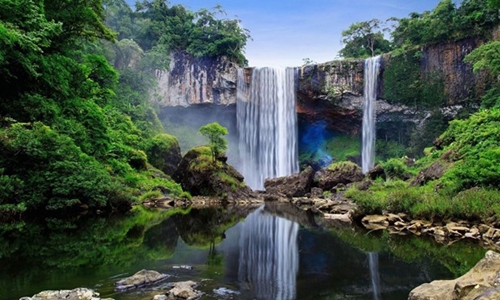The world biosphere reserves in Vietnam are not only UNESCO-recognized designations but are also gradually becoming models of sustainable socio-economic development for local communities, Nhan said.
As areas with special nature and biodiversity values, the 11 world biosphere reserves in Vietnam have been recognized by the United Nations Educational, Scientific and Cultural Organization (UNESCO) and play a crucial role in conserving and developing ecosystems, preserving the environment and adapting to climate change.
    |
 |
|
K50 waterfall in Kon Ha Nung Biosphere Reserve in the Central Highlands province of Gia Lai |
According to Nguyen Chi Thanh, Director of the Research Center for Forests and Wetlands under the Vietnam Union of Science and Technology Associations, the wetland ecosystem in Can Gio Mangrove Biosphere Reserve in Can Gio district, Ho Chi Minh City, is extremely valuable, helping create urban green areas and landscapes, protect and prevent coastal erosion, and respond to climate change, especially sea level rise and high temperature.
Meanwhile, Ca Mau Cape World Biosphere Reserve with the core areas of Ca Mau Cape National Park, U Minh Ha National Park and Western coastal protection forest of the Mekong Delta province of Ca Mau, and its buffer zones, have created a large corridor of diverse landscapes and ecosystems, including mangrove ecosystems, mudflats, peat swamp forest and marine ecosystem. It is home to rich biological and geological resources with high conservation value.
Mangrove forests in Ca Mau Cape National Park play an important role in protecting, preventing winds and erosion; improving the environmental, reducing temperature fluctuations, and regulating rainfall, contributing to climate change adaptation and rising sea levels.
A representative of the Can Gio Mangrove Biosphere Reserve Management Board, said the unit has implemented various research, and conducted resource assessment programs with the aim of increasing forest coverage, conserving biodiversity, and promoting sustainable development.
It has also focused on conservation and development activities, promoting conservation and development efforts in buffer and transitional zones of the reserve; as well as investing in developing systems of bridges, roads, canals, and paths in the forest, facilitating the inspection and conservation work, and socio-economic development.
Recently, the Ho Chi Minh City Party Committee issued a resolution on developing Can Gio district until 2030, aiming to turn Can Gio into a high-end resort and eco-tourism city in the region.
To that end, efforts are needed to manage, protect and sustainably develop Can Gio Mangrove Biosphere Reserve into a model of the harmonization of biodiversity conservation and natural ecosystems, improvement of livelihood and community well-being, and promotion of traditional cultural values and sustainable green economic growth.
Ho Chi Minh City has mechanisms and policies in place to attract scientists, businesses, and the local community to actively join and collaborate with the municipal authorities in managing, conserving, restoring and developing mangrove forest areas to maximize the role and value of the biosphere reserve.
At Ca Mau Cape Biosphere Reserve, management and conservation activities for natural resources and biodiversity conservation have been implemented actively through different measures.
The Ca Mau Cape Biosphere Reserve Management Board has cooperated with a number of organizations and units to investigate and build a database of wild animals in Ca Mau Cape National Park.
Attention has been paid to combining conservation and development, and promoting ecotourism activities in localities, helping create livelihoods for locals, and protecting ecosystems and biodiversity of the biosphere reserve.
Prof. Nguyen Hoang Tri, Chairman of the National Committee for Humans and Biosphere of Vietnam said the successful conservation of biodiversity and nature in biosphere reserves in Vietnam is an important basis for attracting tourists and promoting tourism development.
Typical products and services associated with the biosphere reserves will contribute to promoting economic development and creating harmonious and sustainable development, he said.
Source: VNA